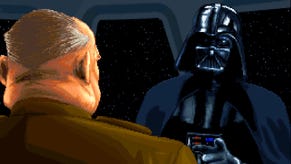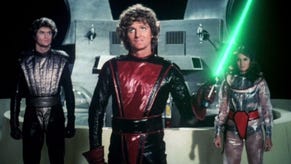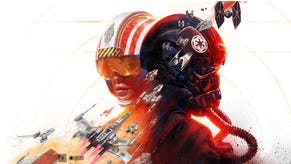Imperial: Revisiting X-Wing And TIE Fighter
Playing both sides
To commemorate the digital release of classic Lucasarts games X-Wing and TIE Fighter [Steam or GOG for the best versions here and here], we commissioned Rob Zacny to take a trip down memory lane and into the laser-singed spaces between the stars. He came back with extensive thoughts as to the quality of the games, and their place in Star Wars lore and legend.
Before X-Wing came out in 1993, the Star Wars universe wasn't really something you could experience firsthand. It existed in the background of a trilogy that was tantalizing in its vagueness toward its own setting and backstory. Every frame showed you something amazing and a little bit perplexing, and then it was gone as the action moved on.
For a generation of kids who grew up watching and re-watching the movies on worn-out VHS tapes, those painted backdrops, strange puppet-aliens, and model spaceships raised a thousand questions and desires. "Wait, tell me more about that!"
But nobody had been able to make a game that felt like it was set in the Star Wars universe. On the Super Nintendo, Star Wars games meant re-telling the familiar stories via the medium of an action platformer. Luke needs to meet-up with C-3PO and R2-D2? Well, of course that means including the scene where Luke spends three hours killing Jawas and shredding their sandcrawler.
It certainly changes that scene in A New Hope where Luke and Ben Kenobi encounter the burned-out husk of the Jawa crawler. "Only Imperial stormtroopers are so precise," Kenobi declares, while Luke's feigned farm-boy innocence masks the heart of a remorseless, indefatigable killing machine. God only knows what sort of Cronenbergian violence would have unfolded had he actually made it to Tosche Station.
X-Wing changed all of that. It purported to actually simulate the things we saw in the movies, telling fans what they'd desperately wanted to hear: "It's all real." It took the two major space battles of the series, the Battle of Yavin and the Battle of Endor, and extrapolated a world of military sci-fi. Ship models that had played scarcely any meaningful role in the films (the only thing we see an A-wing do in the movies is accidentally kamikaze the bridge of the Executor) turned into special-purpose military spacecraft. That impractical-looking medical ship in the Rebel fleet? Why, that's a Nebulon-B Frigate, the primary workhorse of the Rebellion!
It was a milestone when it came out, but the swift arrival of TIE Fighter a year later pushed X-Wing dangerously close to obsolescence, and I have to admit I find the game almost unbearable now. It's clearly the first game in a series, before Lawrence Holland's team at Totally Games had perfected the formula. It's also a game that is at once circumscribed by too much knowledge from the films, and not enough.
Because what, really, do we know about the Rebel Alliance from the films? We know they generally prefer hiding, and that they're always ready for quick getaways: Moff Tarkin is disappointed but not surprised to find that the Rebels have evacuated the Dantooine installation that Princess Leia reveals under interrogation. We know that the Rebel fleet, even at its strongest, could not long-survive a stand-up fight with Imperial warships. We know that the Rebels will give absolutely anyone the rank of general, provided that person is a smuggler who seems cool about the whole thing.
It's not much to go on, so X-Wing hits those same beats again and again and again. You protect a Rebel convoy during yet another inglorious retreat. You raid an Imperial convoy carrying especially valuable cargo. There isn't much variety in the kinds of ships and battles you encounter, either. You never get the feeling of taking part in anything like the Battle of Endor. Rebel and Imperial capital ships tend to stand-off across the map from one another, dueling via small waves of fighters. And it's the same ships again and again: a frigate here, a Star Destroyer there, and now and then a freighter Mon Calamari Cruiser.
But playing it today, I think what really kills X-Wing is the fact that you're playing as the plucky underdog. It's a recipe for frustrating mission design: time and again, you are sent in alone or almost alone, and given an impossible laundry list of objectives. There's a mission halfway through the first campaign where they stick you in a Y-wing (the hand-me-down minivan of the Rebel Alliance) and tell you to inspect a herd of Imperial transports, disable the ones carrying Rebel prisoners, destroy all the rest, all while dogfighting waves of Imperial fighters who are trying to attack the Rebel rescue teams. Fail any of these goals and you have to start over.
Of course, in this sense X-Wing is much more of an old-fashioned videogame. Death and failure are frequent and punishing, and only through repetition and memorization can you succeed in each mission. X-Wing is a game you are supposed to "beat" rather than experience. Playing it today, I have no idea how I slogged through it all those years ago. Every other mission is an invitation to ragequit.
TIE Fighter is something very different.
The real secret of TIE Fighter's success is that it is fascinated by the process of empire. What does an empire look like from the inside, when it wears its imperialism so nakedly on the outside? How do its participants convince themselves they're the heroes? And what's the challenge of waging war when you have all the military resources in the galaxy at your disposal?
But it's not exactly the Empire from the movies. What we see in the movies can't really answer those questions, because that version of the Empire is just too weird. You can't do much with a Sith Lord who spends an entire movie choking-out flag officers, or an Emperor who decides to put his Empire on hold while he hangs out with his deadliest enemy and his deadliest enemy's father, bragging about prophecy.
So TIE Fighter makes a bold move by putting the movies squarely in the background to focus on the Empire as presented by TImothy Zahn's landmark Heir to the Empire novels, which concluded the year before TIE Fighter came out. Those characters represented something that the films had hand-waved away, the idea that the Empire believed it represented order in a chaotic universe. Even though their cause and many of their means were evil, they were presented sympathetically. Empires, like the freedom fighters they attempt to crush, need their ideals.
And so, for much of TIE Fighter, you bring peace and order to the galaxy at the point of a gun. You police the frontiers of the Empire, hunting down Rebels fleeing Hoth. You break up a regional war that threatens to turn into a genocide. You establish an outpost in pirate-infested space and break their hold over it. You root out a traitorous Imperial admiral and join the task force assigned to preventing his defection. It makes sense of the Empire in a way that the Alderaan-destroying cartoon Nazis of the trilogy never did.
Just as important, TIE Fighter obsesses over the details of what running the Empire would have been like. It's a game in which every mission is a nesting-doll of objectives and complication. Where X-Wing missions were straightforward exercises in delaying-tactics or hit-and-run, TIE Fighter is about the difficulty of using overwhelming power effectively. The Empire might have everything plus the kitchen-sink, but all the pieces have to come together. The right targets have to be identified and disabled, assault transports protected on their way to a hostile boarding operation, Interdictor cruisers in position to hold everyone in place, and enemy bombers intercepted before they can punch a hole in the cordon.
It makes the missions very different depending on what role you are playing. A TIE Fighter mission is rarely straightforward. And that's partly because TIE Fighter's ships aren't nearly as versatile and durable as their Rebel counterparts. The flimsy TIEs can't carry an entire mission on their backs, not even with an ace human pilot at the controls. So it forces you to think about your role in the overall battle. You always have a front-row seat for a Star Wars space battle… but you're not the main character the way you are in X-Wing. You play your part and do what your flight officer tells you before the mission, and see how it all unfolds.
It's been striking, playing TIE Fighter today, and seeing just how well the game discourages you from any heroics. Almost without fail, every time I start chasing extra kills to run up the score in a mission, I end up getting blown out of the sky by a stray laser blast or an unfortunate collision with a chunk of smashed Y-wing. Where X-Wing teaches you to race around a mission, trying to put out every single fire, TIE Fighter teaches you to concentrate on your mission and trust in the overall plan.
At least, that's how TIE Fighter worked until its expansions came along. It's ironic that the Collector's CD-ROM might be the definitive version of TIE Fighter, but it's also the one that well-and-truly jumps the shark in its later campaigns.
The problem is that somewhere toward the end of the original TIE Fighter, it starts turning into a traditional videogame power fantasy. The campaign leads up the reveal of a new super-fighter, the TIE Defender, and lets you fly alongside Darth Vader for the climactic battle. In the context of the original game, it's a fine denouement. You have gone from being an anonymous TIE pilot working on the frontier to being a hand-picked praetorian to the Emperor and Vader. You also get a wildly unbalanced ship with which to wreak havoc, after toughing out the majority of the campaign in fragile, unshielded TIEs.
But TIE Fighter had nowhere interesting left to go after that conclusion. The next expansion focused on that ridiculous TIE Defender, and gave you increasingly obnoxious missions and enemies in order to compensate for the Defender's excessive capabilities. Then, just in case that wasn't absurd enough, TIE Fighter introduces the Missile Boat, which is what it sounds like: a flying missile machinegun. The thing that had makes TIE Fighter so great — its demotion of the player to supporting-character status — vanishes as you become an Imperial superhero at the controls of fanciful super-ships.
Still, even in some of its weakest moments, I like that TIE Fighter remains a multi-faceted exploration of the Empire. There are times when you seem to be providing stability and order in places that badly need it. You crush pirate bases and snuff out a war before it can really start. You prevent a coup by a power-hungry weapons designer.
But then there are all the ways TIE Fighter hints at the rot underlying the entire edifice. You become an Imperial informer, conducting side-missions without your commanders' knowledge. You are constantly helping protect the development of super-weapons, only to watch as their creator goes rogue and turns them against you. One high-ranking Imperial officer after another turns his coat, as if there's something about the Empire itself that breeds megalomania. And with each mission, with each new campaign, your commanders promise you that this time, this fight, will be the last. That just over the next pile of dead bodies and broken starships, you can bring peace to the galaxy. You just have to believe, and to keep following orders.






















